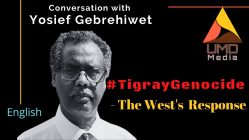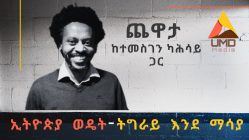Tewodros Tsegaye
Tigray—a region that recently stood at the epicenter of one of the most brutal conflicts in modern African history—remains deeply scarred. Besieged by a genocidal alliance and left in disarray, it has endured a catastrophic humanitarian crisis. Now, as the international spotlight fades, Tigray finds itself ensnared in a new and insidious quagmire—this time, from within.
Still reeling from war, Tigray has spent the past two years consumed by a bitter internal power struggle within the Tigray People’s Liberation Front (TPLF). Two years after the Pretoria Agreement brought a fragile halt to open hostilities, the opportunity to rebuild has been squandered. Instead of facilitating the return of displaced persons, restoring constitutional governance, or beginning the monumental task of rehabilitation, the TPLF has been mired in infighting and political maneuvering.
As a result, the interim administration led by Getachew Reda ended its term without delivering meaningful outcomes. Hundreds of thousands of internally displaced persons remain stranded in camps under appalling conditions. Constitutional territories remain under occupation. No credible accountability process has been initiated for the atrocities committed. Nor is there any substantive political dialogue underway to address the root causes of the conflict. What is happening in Tigray demands serious examination—through local, national, and international lenses.
1. Leadership Crisis: From Getachew Reda to Tadesse Werede
Getachew Reda has now been replaced by his deputy, General Tadesse Werede. Whether Tadesse can lead Tigray through this volatile period remains uncertain. Skepticism abounds, particularly after Reda publicly accused him of conspiring against the very administration he served.
Several factors feed this skepticism:
- Neglect of duties: As army chief and vice president, Tadesse’s neglect significantly contributed to the paralysis of the interim administration.
- Undermining the administration: At times, he drew false equivalencies between government officials and party cadres, empowering TPLF’s old guard and undermining reform efforts.
- Strategic shapeshifting: Tadesse often shifted between roles—vice president, military leader, and private citizen—evading responsibility and positioning himself for power.
- Loyalty to the old guard: His nomination by entrenched TPLF figures who have resisted reform—and his current cabinet choices—signal an alarming alignment with reactionary forces.
Whether he can break from these forces and lead Tigray toward recovery remains to be seen. His early actions, however, only deepen fears that he will serve as a puppet of the old guard, prolonging Tigray’s suffering.
Most alarmingly, the faction he seems to align with is reportedly maneuvering to rekindle conflict—this time, by forging an alliance with the Eritrean dictator. This brings us to the second critical dimension: the regional threat.
2. Regional Implications: A Fragile Horn of Africa
While internal dysfunction has clearly contributed to Tigray’s stagnation, external actors are now actively exploiting its vulnerability. This is not a localized political dispute. Left unchecked, it risks spiraling into a broader regional crisis.
2.1. Abiy Ahmed’s Calculated Undermining
Prime Minister Abiy Ahmed’s actions over the past two years reveal a clear unwillingness—if not outright refusal—to fully implement the Pretoria Agreement. His behavior suggests a deliberate strategy to weaken Tigray and suppress any resurgence.
- Fear of a resurgent Tigray: Despite Tigray’s shattered infrastructure and economy, Abiy perceives it as a threat to his rule. The TPLF’s internal implosion has offered him the perfect pretext to intensify pressure.
- Preventing opposition alliances: Abiy is determined to prevent the Tigray Defense Forces (TDF) from forming coalitions with other insurgent groups.
- Territorial obstruction: His refusal to return occupied territories has made the repatriation of displaced persons nearly impossible, stalling reconciliation efforts.
2.2. Isaias Afwerki’s Destabilization Strategy
If Abiy has actively undermined peace, Eritrean dictator Isaias Afwerki has openly opposed it.
- Unfinished Business: For Isaias, the Pretoria Agreement was a betrayal. He had hoped for the total destruction of Tigray’s political foundation.
- Ongoing Occupation: Eritrean forces continue to occupy parts of northern and northwestern Tigray, harassing civilians and regrouping for potential future conflict.
- Divide and Rule: In a cynical twist, Isaias is reportedly courting Debretsion Gebremichael’s faction within the TPLF, deepening internal divisions to weaken Tigray further.
Both Abiy and Isaias—once collaborators—are now separately maneuvering to keep Tigray fractured and powerless.
3. Final Thoughts: Tigray at a Critical Juncture
Tigray is not experiencing a simple post-conflict transition; it is facing a full-blown existential crisis. Its people, already burdened by war, displacement, and famine, deserve more than political stagnation and external manipulation.
To avert a second catastrophic war, urgent action is needed:
- End TPLF monopoly: International observers, including the U.S. and EU, must ensure an inclusive political process in Tigray. The TPLF must not be allowed to monopolize power once again.
- Pressure Abiy to implement Pretoria: Immediate and full implementation of the Pretoria Agreement—including the return of occupied territories and the repatriation of IDPs—is non-negotiable.
- Promote national dialogue: Ethiopia’s lasting peace hinges on an inclusive and credible national dialogue—one that genuinely embraces political pluralism and federalism, not the narrow process being orchestrated by Abiy Ahmed.
- Hold Eritrea accountable: The international community must stop Isaias Afwerki’s reckless interference and hold him responsible for grave crimes in Eritrea and across the region.
The international community failed to prevent the last war despite having immense leverage. Now, another war looms. The cost of silence will not only be measured in Tigrayan lives lost—it will destabilize the entire Horn of Africa, with Middle Eastern powers fanning the flames of a new regional inferno.
Without urgent international engagement, sweeping political reform, and sustained pressure on both Addis Ababa and Asmara, peace will remain a distant dream—and chaos will prevail.
Editor’s Note: The opinions expressed in the articles published on UMD Media are solely those of the individual authors and do not necessarily reflect the views or opinions of the editorial team or UMD Media as an organization. The publication of any opinion piece does not imply endorsement or agreement by UMD Media. Readers are encouraged to critically evaluate the content and form their own conclusions. Leave your comments below. Send us your thoughts and reflections to umd.media.2020 at gmail dot com.
Subscribe to UMD Media channel. Join UMD Media Telegram Channel: https://t.me/UMDMedia






Add comment